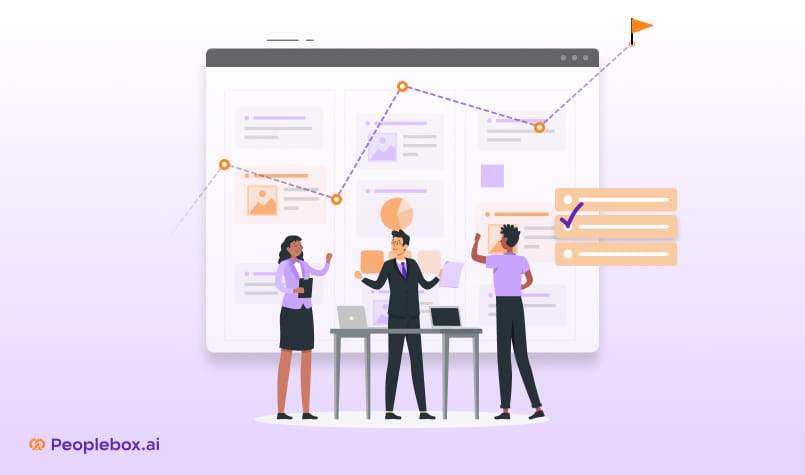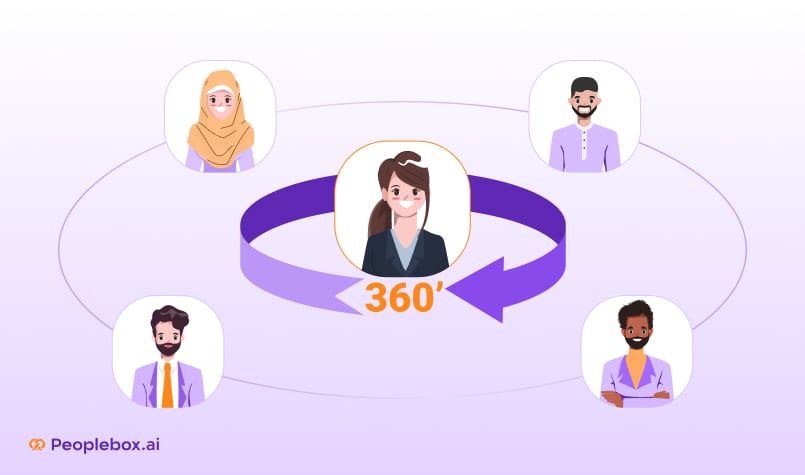Do you feel disconnected from your employees, unaware of their challenges, the projects they work on, and the innovative ideas they might have?
This lack of firsthand knowledge about your employees can lead to misaligned goals, overlooked talents, and missed opportunities for innovation. It can create a barrier between you and your team, making it harder to build trust and create a collaborative environment.
Skip level meetings are the key to bridging this gap and gaining a clear, firsthand understanding of your employees’ activities. In this guide, we will explore the concept of skip-level meetings, outline best practices for excelling in them, and provide a comprehensive list of questions to ensure productive and smooth meetings.
Let’s dive in.
What are Skip level Meetings?
Skip level meetings are special meetings where you meet with employees who are at least one level below your immediate report.
These meetings allow you to bypass the usual communication chain and hear directly from frontline employees. Skip-level meetings allow you to build connections with your employees. They help improve transparency, uncover hidden problems, and discuss their solutions.
Purpose of Skip-level Meetings: Why Do You Need Them?
The purpose of 1:1 skip-level meetings is to gather valuable insights to enable better leadership, analyze the company’s operations, and build a transparent communication chain.
These 1:1 meetings bridge the gap between both parties—senior leaders get to see and understand your employees’ side of the story, and employees gain invaluable expertise from your leaders.
Benefits of Skip-level Meetings
Reduce barrier between lower and upper management
Sometimes, upper management doesn’t see the challenges on the frontline. These meetings reduce that barrier by allowing managers to communicate with frontline employees and discuss solutions. Skip level meetings also provide a learning opportunity for both parties involved.
Daniel Nyquist, Chief Marketing Officer at Crosslist, shared the importance of employee feedback. He said, “An employee once told me they needed more clarity on project priorities so they could focus their efforts. This insight helped me better guide their manager, ultimately improving productivity and morale.”
Helps in employee development
You can spot candidates’ strengths and weaknesses in skip-level meetings and allot projects accordingly. For example, if an employee shares long-term objectives during a meeting, you can suggest projects or initiatives that they might value.
Employees also benefit from skip-level meetings as interacting with you gives them a sneak peek into the company’s long-term goals and strategies.
Build rapport between employees and management
Skip level meetings make you more accessible to employees. You get a sneak peek into their daily lives. This fosters transparent and open communication, which builds trust and makes employees feel more confident in their work.
Sunaree, Head Of Human Resources at Cupid PR, says, “Our CEO’s willingness to listen without judgment and actionable follow-up made the team begin to open up about the obstacles they faced and the resources they needed. It helped the CEO gain key insights that led to important structural changes.”
Best Practices to Conduct Skip level Meetings as a Senior Leader
To lead productive 1:1 skip-level meetings as a senior leader, use these best practices:
Prepare beforehand
To prepare for a skip-level meeting, you can review recent performance data, project updates, and feedback from direct managers. This will help you understand the context and any potential issues.
Once you have the background knowledge, set a clear agenda for the meeting. Introduce the purpose and value of the meeting to employees in advance, emphasizing that it is an opportunity for open dialogue and constructive feedback.
Also, assure employees that their input is confidential and valued. This encourages them to speak candidly about their experiences, challenges, and suggestions for improvement.
Create a safe space for the candidate
Getting on a call with a senior leader can be intimidating for employees. That’s why it’s your responsibility to create a safe space for them to open up.
To create such an environment, Harvard Business Review recommends focusing on two key aspects: permission and safety.
- Permission: Allow employees to express their thoughts without compromising their assumptions. Encourage them to be honest and transparent with their questions, suggestions, and challenges.
- Safety: Employees might hold back despite having permission to speak because they fear being exposed. So, explicitly assure them about the confidentiality of the conversation.
Address concerns of the employee
When an employee opens up, you must listen to them patiently. Give them enough room and time to articulate their questions, form their ideas, and discuss them clearly.
Along with verbal communication, pay attention to non-verbal cues – crossed arms, lack of eye contact, etc. – as they can reveal whether the employee is holding back or feeling hesitant.
If you notice such cues, pause and address them directly. Such pauses show that you genuinely listen to their concerns and are willing to understand.
Ask for feedback
Ask for feedback to understand how helpful the meeting was for the employee. Here are some closing questions you can ask:
- Is there anything else you’d like to share that hasn’t been covered?
- Do you have any ideas on how we can make this meeting more effective or valuable for you?
- Do you feel that your concerns and suggestions were heard and understood?
- Do you have any feedback for me on how I can better facilitate these meetings?
Asking for feedback helps improve future interactions. Feedback shows that you value the employee’s time and opinions and are committed to making the process as effective and beneficial as possible.
Remember to thank the employees for their honest feedback and follow up on any actionable points they raise. This will demonstrate that you’ve taken their input seriously.
To do this, you can do these meetings with Peoplebox.ai and review the most mentioned points. This will allow you to be fully attentive during the meeting instead of jumping in and out to write your thoughts down!
Best Practices to Prepare for Skip-level Meetings as an Employee
Prepare comprehensive talking points
Clearly outline the key points you want to discuss with the executives for an insightful and enriching conversation. You can take a self-assessment test to identify your KPIs, strengths, and weaknesses.
Gauri Manglik, CEO & Co-founder of Instrumentl, shares, “Employees should come armed with 2-3 well-thought-out talking points highlighting your achievements and contributions over the past quarter or year. Quantify your impact whenever possible.”
While outlining your achievements, make them specific and quantifiable.
For instance, instead of saying, ‘I helped boost team productivity,’ say, ‘I introduced a new project management tool that increased team productivity by 25%, resulting in the on-time delivery of all projects over the past year.’
Some talking points employees can use during these meetings:
- Ask about the company’s growth plans
- Lay out current problems you’re facing
- Outline objectives and key results (OKRs)
- Discuss career advancement opportunities
- Enlist innovative ideas or projects you are working on
Learn about your leader
It’s natural to feel intimidated, especially when you’re going to these meetings for the first time. Thoughts like, ‘What if I ask the wrong question?’ or ‘What if I don’t know the answer to a question?’ are more common and understandable.
To overcome this, gather as much information as possible about the senior leader. By doing so, you can feel at ease and be able to lead organic conversations, which will help you make a lasting impression on senior managers.
Jon Gordon, Managing Partner and co-founder at Sheer Velocity talks about how he made a really good impression on his executive vice president. He says, “I reviewed recent talks he had given, looked at the company’s strategic plan, and studied the goals and KPIs for his division.”
Gather insights from upper management
Senior leaders have years of experience to share. These meetings are your gateway to tapping into those experiences.
Ethan Evans, a Retired VP at Amazon, shares how skip levels are the ultimate source of knowledge. He says, “Assuming an average manager has 6 reports, then the skip has roughly 36 times the span (budget, projects, people) you do. That means a whole different picture.”
So, pay attention and ask follow-up questions to clarify your ideas. Treat these meetings as an opportunity to learn from senior leaders’ experiences.
Popular Questions for a Skip-level Meeting
Introductory questions
- How are you feeling about your current projects and workload?
- Can you tell me a bit about your role and what a typical day looks like for you?
- What has been your proudest accomplishment in the past few months?
- How do you feel about the support and resources you’re receiving from the company?
- What motivated you to join our company, and what keeps you here?
Identify best operations and gain new ideas
- What’s going better now than it was 6 months ago?
- What’s working well in the organization that I should know about?
- Given the challenges our industry faces, what are some steps you’re taking to stay informed and deliver your best work?
Learn about the challenges
- What are we not making enough progress on/What are the biggest roadblocks to your team’s success?
- If you could change one thing about the company or your team, what would it be?
- What are you concerned about that nobody is telling me about?
- How do you feel about the level of collaboration within your team? Any suggestions for improvement?
- If there was one thing that you could “fix” in the company, what would it be?
Gain insights into employee development
- What’s one thing I could do better to support you and help you succeed?
- If you could work in any department for a week, which one would you want to work in? Why?
- What’s one change you think we could make that would have a significant positive impact on your career?
Closing questions
- Is there anything we haven’t discussed that you think is important for me to know?
- What can I do to support you and your team better moving forward?
- How can we make these meetings more beneficial for you in the future?
How to Conduct Skip-level Meetings with Peoplebox?
Peoplebox.ai helps you conduct smooth and effective 1:1 skip-level meetings without any hassle.
To schedule a meeting, either sync your calendar (it integrates with Microsoft Teams, Google Calendar, etc.) to fetch all the scheduled meetings in a single place or create 1:1 meetings in Peoplebox directly.
Once the meeting is scheduled, create a private or shared space to share meeting notes. Peoplebox.ai also suggests talking points based on the meeting’s context, making it super easy to dive into organic conversations.
Also, you can leverage an AI meeting assistant that helps you convert your meetings into actionable notes.
Embrace Skip-level Meetings with Peoplebox
A good 1:1 skip-level meeting can resurface bottlenecks, address key issues, and disperse valuable insights. By preparing in advance and building a safe environment, senior leaders can connect with employees two or three levels down and gain unfiltered feedback, opinions, and ideas.
While you focus on conducting an exception skip-level meeting, Peoplebox.ai can handle all the technicalities. You just have to schedule the meeting and add the agenda and notes.
Peoplebox.ai will share talking points suggestions, convert keynotes into actionable items, and track their progress. Book a demo today to conduct your skip-level meetings!







